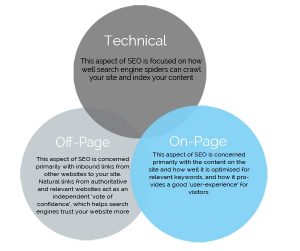Columnist Rachel Lindteigen discusses the ins and outs of performing a content audit and how to use the data you uncover to make shifts in your strategy.
 Last month, I wrote about the importance of running a content audit and how to do it. I want to dig into the data further now and talk about how we can leverage the data in the audit and use it to make decisions. The content audit can help you streamline your content strategy if you understand what the numbers are telling you.
Last month, I wrote about the importance of running a content audit and how to do it. I want to dig into the data further now and talk about how we can leverage the data in the audit and use it to make decisions. The content audit can help you streamline your content strategy if you understand what the numbers are telling you.
As you look at the data within your audit, you may find that your results show a lot of noise and a little stellar performance. I’ve seen some audits where as few as five blog posts drove up to 50 percent of the traffic for a site.
So, if five posts drive 50 percent of the traffic, what do the other 200, 300, 500 or more posts do? Not much.
What does this mean, and how do you act upon this information? If your site has a few posts that drive a lot of traffic and a lot of posts that drive a little engagement, you may think you need to just replicate the top-performing posts and cut out the low-performing posts to be more successful — but that might be a mistake.
Making a decision based upon just the first level of data could be dangerous. Have you considered the distribution of the posts? This could have more to do with performance than the content itself.
I recently did a distribution analysis on a client’s blog and found they had a 10:1 increase in traffic when they highlighted the blog post in an email versus just posting on the blog. That’s huge.
What to ask when looking at the data
As you look at your data, review the top five to 10 posts and the bottom five to 10 posts. Analyze the two sets and answer a few simple, but important, questions:
- Who was the target audience for this post/page?
- What was the post/page about?
- Was anyone else part of the development of the post/page? Are there influencer quotes?
- How was the post/page shared and amplified?
- What are the similarities and differences between this post and others in both the top and bottom performers?
Once you’ve reviewed the data and have some potential trends, you can use the information to adjust your content strategy as necessary. If you were to make determinations about a piece of content’s performance without considering factors such as amplification, distribution differences or influencer inclusion, your conclusions could be flawed.
If all five top posts were included in an email blast and shared on your social media channels but the bottom five posts only went live on the blog — no social sharing and no email — then it might not be the topic but rather the amplification and distribution that made the difference.
Likewise, if your top posts all included research or a third-party quote, then that could be impacting the performance in several ways. The research could have resonated with your audience, and the third-party person might have shared the post in their network, increasing the reach.
After you’ve reviewed both the content performance and the distribution, then you can make an informed decision about what do to with the data. You’ll want to analyze performance trends and dig deep to try to understand what exactly is working.
Digging deeper
What should you look at as you try to answer the big questions?
- What topics are the top posts about?
- Are there images? If so, how many?
- Are there videos?
- Are the posts about trending topics, research? Are they controversial?
- Were the posts shared across all social channels? Was the content the same or customized for each channel?
- Is there a difference in word count or readability for the posts?
- Are there differences in the headlines?
Work to identify trends. It’s possible that what’s working well may surprise you.
Dig deep until you feel comfortable that you understand the trends. This helps you better serve your customer. When you know what they’re interested in, you can provide better information in the future.
Pay close attention to both what’s working and what’s not. You’ll also want to review some of the average-performing posts to see if there’s anything you can learn from them.
The goal is to really understand why certain pieces of content perform and others don’t, so you can eliminate the noise on your site. Why write content that isn’t going to resonate with your audience? It’s a waste of both time and effort.
Talk it over with someone else
If you find a trend that doesn’t seem to make sense, talk it over with someone else and see if maybe you’re missing something. I had this happen to me recently.
I’d spent hours analyzing a client’s blog and had come to a conclusion that made absolutely no sense to me, and for good reason — it was 100 percent wrong. But it took talking it through with someone else for me to realize where I’d made the mistake.
It seemed like my client’s holiday blog posts weren’t effective; I couldn’t imagine how that was possible, as the holidays are critical to them, and they have a great customer-facing blog. However, the numbers showed that they had almost zero engagement for their holiday posts.
I knew there was no way this was the case. When I spoke with a co-worker and said something to her about my confusion, she immediately asked what date range I was looking at, and sure enough, I had used a YTD range, and because it’s September, the holiday pages weren’t applicable yet.
When I reran data for only the holiday pages, using Q4 2015 as my date range, it showed a huge performance leap for those same pages. In fact, their engagement and returning visitor numbers were almost double during the holiday period.
Had I shared the initial data with the client, they could have made a huge mistake with their content strategy. By digging deeper, I found the mistake and unlocked the true story.
Why do I share insights into my own mistake? Simply because it can happen to anyone.
When you spend lots of time digging into data and analyzing and — let’s be honest — staring at a giant Excel spreadsheet, you can miss something. If you feel that the data you’re seeing doesn’t make sense, sometimes there’s a good reason.
If, like me, you’ve spent too many hours looking at the same data, it might be good to have someone else take a look and see if they get a different answer.
Adjust your strategy
After you’ve done your analysis and checked for any potential mistakes, and you know what type of content works best, how many images you should include, which distribution channels are best for you and so on, you should adjust your content plans to reflect what’s working.
Adjust and improve your content on a regular basis. Always push for better performance. When you home in on what your audience wants and do a great job of delivering, you can likely do more with less.
Wouldn’t it be fantastic to be able to create a few outstanding content pieces each week or month and see significant performance improvements? A really good content audit can help you do just that.
Give it a try and let me know if you find trends that surprise you. How are you going to adjust your strategy based on the results of the audit?
Some opinions expressed in this article may be those of a guest author and not necessarily Marketing Land. Staff authors are listed here.
Marketing Land – Internet Marketing News, Strategies & Tips
(35)







